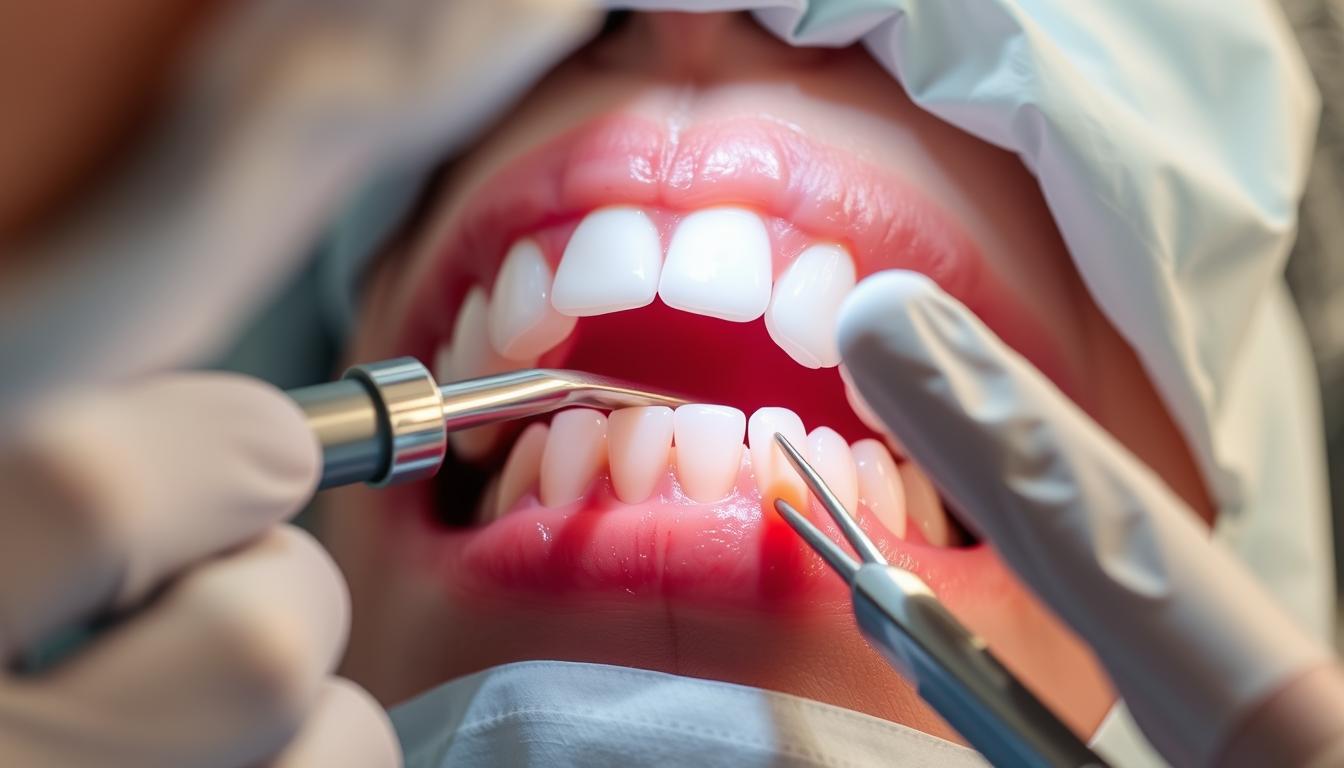Crown lengthening is a common dental surgical procedure that reshapes the gum tissue and, sometimes, bone around one or more teeth to expose more of the tooth structure. Whether you’re considering this procedure for functional reasons like preparing for a dental crown or for aesthetic improvements to reduce a “gummy smile,” understanding what crown lengthening involves can help you make informed decisions about your dental health.
What Is Crown Lengthening?

Crown lengthening is a surgical procedure that involves removing excess gum tissue and, in some cases, bone from around the teeth to expose more of the tooth structure. The term “crown” refers to the portion of your tooth that’s visible above the gumline, not the artificial dental crown that’s placed over a tooth.
This procedure is typically performed by a periodontist, a dental specialist who focuses on the supporting structures of teeth and the treatment of gum disease. Crown lengthening can be performed on a single tooth, multiple teeth, or the entire gumline to create a more aesthetically pleasing smile or to prepare teeth for restorative procedures.scaling & root-planing
When Is Crown Lengthening Recommended?
Functional Reasons:
- To expose more tooth structure when a tooth is broken below the gumline
- To access subgingival (below the gumline) decay
- To create enough tooth structure for a dental crown or bridge
- To establish a proper “biologic width” – the space needed between a restoration and the bone
- To access a tooth fracture that extends below the gumline
Aesthetic Reasons:
- To correct a “gummy smile” where excess gum tissue makes teeth appear short
- To create a more even gumline
- To improve the appearance of asymmetrical or uneven teeth
- To enhance the overall appearance of your smile
- To correct altered passive eruption (when gums don’t recede properly as teeth erupt)
The Crown Lengthening Procedure: Step by Step
Understanding what happens during a crown lengthening procedure can help alleviate anxiety and prepare you for the experience. Here’s a breakdown of what you can expect:
Before the Procedure

- Initial Consultation: Your dentist will examine your teeth and gums, take X-rays, and discuss your medical history to determine if crown lengthening is appropriate for your situation.
- Preparation: You may receive a temporary crown to protect your tooth until the procedure if crown lengthening is being done for restorative purposes.
- Pre-surgical Instructions: Your dental professional will provide guidelines on medications, eating, and drinking before the procedure.
During the Procedure

- Anesthesia: The procedure begins with the administration of local anesthesia to numb the area. Some patients may also receive a sedative for additional comfort.
- Gum Tissue Removal: The periodontist makes small incisions to separate the gums from the teeth, creating a flap that can be lifted to access the roots and bone.
- Bone Reshaping (if necessary): In some cases, a small amount of bone around the tooth roots may need to be removed to establish the proper biologic width.
- Tissue Repositioning: After the necessary adjustments, the gum tissue is repositioned at a lower level on the tooth and secured with sutures.
- Dressing Application: A periodontal dressing may be placed over the surgical area to protect it during initial healing.
Procedure Duration
The length of the crown lengthening procedure varies depending on the number of teeth involved and whether bone removal is necessary. Typically, the procedure takes between 30 minutes to an hour for a single tooth, and longer if multiple teeth are being treated.
Benefits of Crown Lengthening

Benefits
- Improved Aesthetics: Creates a more balanced, less “gummy” smile by exposing more of your natural teeth
- Better Dental Health: Makes it easier to clean around the gumline, potentially reducing the risk of gum disease
- Enhanced Restorations: Provides a solid foundation for crowns, bridges, or other dental restorations
- Long-lasting Results: Once healed, the results of crown lengthening are permanent
- Increased Confidence: Many patients report feeling more confident about their smile after the procedure
Potential Risks
- Temporary Discomfort: Some pain, swelling, and sensitivity are common after the procedure
- Infection Risk: As with any surgical procedure, there’s a small risk of infection
- Tooth Sensitivity: Exposed tooth surfaces may be temporarily sensitive to hot and cold
- Aesthetic Changes: Teeth may appear longer, which some patients may need time to adjust to
- Potential for Tooth Loosening: If bone is removed, the tooth may feel slightly looser initially
The Importance of Biologic Width
A key concept in crown lengthening is the “biologic width” – the natural space between the top of the bone and the bottom of a dental restoration. This space (typically about 2-3mm) is crucial for maintaining gum health. When restorations invade this space, it can lead to chronic inflammation, gum recession, bone loss, and even restoration failure. Crown lengthening ensures this biologic width is preserved, creating a healthier environment for both natural teeth and dental restorations. Scaling and Root Planing: Complete Guide to Deep Cleaning Treatment
Recovery and Aftercare Following Crown Lengthening

Proper aftercare is essential for successful healing after a crown lengthening procedure. Here’s what you can expect during the recovery process and how to care for your mouth afterward:
Immediate Aftercare (First 24-48 Hours)
- Pain Management: Take prescribed pain medications or over-the-counter pain relievers as directed by your dental professional.
- Ice Application: Apply ice packs to your face for 20 minutes on, 20 minutes off to reduce swelling.
- Bleeding Control: Some minor bleeding is normal. If it continues, apply gentle pressure with a moistened tea bag or gauze.
- Diet Restrictions: Stick to soft, cool foods and avoid hot, spicy, crunchy, or hard foods that could irritate the surgical area.
- Activity Limitation: Avoid strenuous physical activity for the first 2-3 days to prevent increased bleeding.
Ongoing Recovery (1-2 Weeks)

- Oral Hygiene: Brush gently around the surgical area, avoiding direct contact with the wound for the first few days.
- Saltwater Rinses: Rinse with warm salt water (1/2 teaspoon salt in 8 oz water) several times daily to keep the area clean.
- Avoid Tobacco: Refrain from smoking or using tobacco products, which can significantly delay healing.
- Dressing Care: If a periodontal dressing was placed, leave it in place until your follow-up appointment.
- Suture Protection: Be careful not to disturb any sutures with your tongue, toothbrush, or eating utensils. LANAP® Laser Gum Disease Treatment: A Minimally Invasive Solution for Periodontal Disease
Complete Healing Timeline
| Time Period | Expected Healing Progress | Recommended Activities |
| 1-2 Weeks | Initial gum healing, suture removal | Gentle oral hygiene, soft food diet |
| 3-4 Weeks | Reduced swelling, improved comfort | Resume normal brushing, gradual return to normal diet |
| 1-2 Months | Gum tissue stabilization | Normal oral hygiene, possible restorative work can begin |
| 3-6 Months | Complete healing, final gum position established | Final restorations can be placed |
Important: If you experience severe pain, excessive bleeding, pus formation, or fever after your crown lengthening procedure, contact your dental professional immediately as these may be signs of infection or complications.
Cost Considerations for Crown Lengthening

The cost of crown lengthening varies based on several factors, including the complexity of the procedure, the number of teeth involved, your geographic location, and the expertise of the dental professional performing the surgery.
Average Cost Range
Crown lengthening typically costs between $500 to $2,000 per tooth. For aesthetic crown lengthening that involves multiple front teeth, the cost may range from $1,000 to $4,000 for the entire procedure.
Factors Affecting Cost
- Procedure Complexity: Cases requiring bone removal in addition to gum tissue reshaping will generally cost more.
- Number of Teeth: Treatment of multiple teeth will increase the overall cost.
- Geographic Location: Dental procedure costs vary significantly by region and city.
- Specialist vs. General Dentist: Procedures performed by specialists (periodontists) may cost more than those done by general dentists.
- Additional Procedures: If crown lengthening is part of a larger treatment plan (such as crown placement), additional costs will apply.
Insurance Coverage
Insurance coverage for crown lengthening depends on the reason for the procedure:
- Functional Crown Lengthening: When performed for restorative purposes (such as to place a crown on a broken tooth), many dental insurance plans provide partial coverage, typically 50-80% after deductibles.
- Aesthetic Crown Lengthening: When performed purely for cosmetic reasons, most insurance plans do not provide coverage.
Always check with your insurance provider before proceeding with treatment to understand your coverage and potential out-of-pocket expenses.
Who Is a Good Candidate for Crown Lengthening?

Crown lengthening isn’t suitable for everyone. Good candidates for this procedure typically have:
Ideal Candidates
- Good Overall Health: Patients should be in good general health without conditions that might impair healing.
- Healthy Gums: Active gum disease should be treated before crown lengthening is performed.
- Sufficient Bone and Root Structure: Adequate bone support and root length are necessary to maintain tooth stability after the procedure.
- Realistic Expectations: Understanding the potential results and limitations of the procedure.
- Commitment to Oral Hygiene: Willingness to maintain good oral hygiene practices after the procedure.
Factors That May Complicate Treatment
- Severe Gum Disease: Active periodontitis should be treated before crown lengthening.
- Insufficient Crown-to-Root Ratio: If too much bone is removed, tooth stability may be compromised.
- Certain Medical Conditions: Uncontrolled diabetes, immune disorders, or conditions requiring blood thinners.
- Smoking: Tobacco use can significantly impair healing after the procedure.
- Adjacent Teeth Considerations: The procedure may affect neighboring teeth.
The Importance of a Comprehensive Evaluation
Before proceeding with crown lengthening, your dental professional will conduct a thorough examination, which may include:
- Comprehensive dental examination
- Dental X-rays to assess bone levels
- Periodontal probing to measure gum pocket depths
- Evaluation of your overall oral health
- Discussion of your aesthetic goals and expectations
This evaluation helps determine if crown lengthening is appropriate for your specific situation and what results you can realistically expect.
Alternatives to Crown Lengthening

Depending on your specific dental needs and goals, there may be alternatives to crown lengthening worth considering:
For Functional Issues
- Orthodontic Forced Eruption: Using orthodontic techniques to gradually move a tooth upward from the bone, bringing more of its structure above the gumline without removing bone or tissue.
- Gingivectomy: A simpler procedure that removes only gum tissue without altering the bone. This may be sufficient in cases where there is excess gum tissue but the bone level is appropriate.
- Extraction and Implant: In cases where a tooth is severely damaged, extraction followed by an implant may be more practical than trying to save the natural tooth.
For Aesthetic Issues
- Lip Repositioning: For gummy smiles caused by hypermobile lips (lips that rise too high when smiling), a lip repositioning procedure may be more appropriate than crown lengthening.
- Veneers or Bonding: In some cases, the appearance of short teeth can be improved with veneers or dental bonding that creates the illusion of longer teeth.
- Botox: Temporary treatment for gummy smiles caused by hypermobile lips, limiting the upward movement of the upper lip when smiling.
“The best treatment approach depends on the specific cause of your dental issue. What works perfectly for one patient may not be appropriate for another. A thorough evaluation by a dental professional is essential to determine the most suitable option for your unique situation.”
— American Academy of Periodontology
Frequently Asked Questions About Crown Lengthening

Is crown lengthening painful?
During the procedure, you’ll be under local anesthesia, so you shouldn’t feel pain. After the anesthesia wears off, you may experience some discomfort, swelling, and sensitivity for a few days. Your dental professional will prescribe or recommend appropriate pain medications to manage any post-procedure discomfort. Most patients report that the pain is manageable and subsides within a few days.
How long does recovery take after crown lengthening?
Initial healing typically takes about 1-2 weeks, during which time you may experience some swelling and discomfort. Complete healing, where the gums have fully stabilized in their new position, takes about 3 months. If the procedure was done to prepare for a crown or other restoration, your dentist will usually wait 4-6 weeks before taking final impressions to ensure the gums have stabilized sufficiently.
Will my teeth look unnaturally long after crown lengthening?
A skilled dental professional will ensure that your teeth look proportional and natural after crown lengthening. The goal is to create harmony between your teeth, gums, and smile, not to make teeth look unnaturally long. During your consultation, your dentist or periodontist should discuss the expected aesthetic outcome and may even show you digital previews of the anticipated results.
Can crown lengthening be reversed if I don’t like the results?
Crown lengthening involves the removal of gum tissue and sometimes bone, which cannot be reversed. This is why it’s crucial to work with an experienced professional and have a clear understanding of the expected results before proceeding. In some cases, if you’re unhappy with the appearance after healing, other cosmetic procedures might help modify the appearance, but the original tissue cannot be restored.
How long do the results of crown lengthening last?
The results of crown lengthening are permanent. Once the gum tissue and bone are removed, they will not grow back. However, maintaining good oral hygiene is essential to prevent gum disease, which could affect the appearance of your gumline in the future.
Can I eat normally after crown lengthening?
For the first few days after the procedure, you should stick to soft foods and avoid anything hot, spicy, crunchy, or hard that could irritate the surgical area. As healing progresses (usually after 7-10 days), you can gradually return to your normal diet. Your dental professional will provide specific dietary guidelines based on your individual case.
Conclusion: Is Crown Lengthening Right for You?

Crown lengthening is a versatile dental procedure that can address both functional and aesthetic concerns. Whether you need it to prepare for a dental restoration or to enhance the appearance of your smile, the procedure can provide significant benefits when performed by a skilled dental professional.
As with any dental procedure, crown lengthening has its advantages and potential risks. The key to a successful outcome lies in proper patient selection, thorough planning, skilled execution, and diligent aftercare. By understanding what the procedure involves, what to expect during recovery, and what results are realistic, you can make an informed decision about whether crown lengthening is right for you.
Remember that every patient’s situation is unique, and what works for one person may not be appropriate for another. A comprehensive evaluation by a dental professional is essential to determine if crown lengthening is the best approach for your specific needs and goals.
Consult with a Specialist: If you’re considering crown lengthening, schedule a consultation with a periodontist or a dentist experienced in this procedure. They can evaluate your specific situation, discuss your options, and help you decide on the best course of treatment.
Ready to Learn If Crown Lengthening Is Right for You?
Schedule a consultation with a dental specialist who can evaluate your specific needs and determine if crown lengthening could benefit your dental health or enhance your smile.Find a Specialist Near You
Get Personalized Information About Crown Lengthening
Every patient’s needs are unique. Schedule a consultation with a dental specialist to get personalized information about crown lengthening, including cost estimates specific to your situation.Request a Consultation

uhyktl
x4u4mp